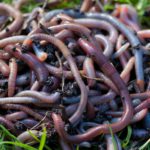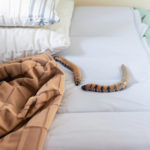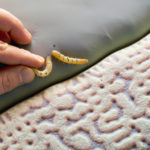The household casebearer, or plaster bagworm (Phereoeca uterella), is a small moth member of the Tineidae family. This species, widely distributed throughout the globe, is well-known for its unusual behavior and appearance as a larva, which resembles a cinder worm due to its distinctive, elongated body and protective casing.
The following are some salient features and details regarding plaster bagworms:
Larval Stage of Plaster Bagworm
The larval stage is the most noticeable and identifiable stage of the plaster bagworm’s life cycle (Phereoeca uterella). The larval stage has the following salient characteristics:

Size
Larvae of plaster bagworms are generally tiny, with lengths ranging from 1/2 to 5/8 inch (1.27 to 1.59 cm).

Color
Their coloring is typically brown or gray, which helps them blend in with the materials used to make their protective cases.

Protective Case
Developing protective cases is one of the larval stage’s most distinguishing features. The larvae build these cases using silk threads and various detritus from their surroundings. Particles such as sand, lint, fibers, and others may be utilized in the case. The case acts as a shelter, giving the larva cover and protection.

Movement
Larvae of plaster bagworms are mobile within their cases. They use silk threads to secure the points to surfaces, and as they develop, their patients may enlarge or take on new features.

Feeding Habits
It is known that the larvae consume a wide range of organic materials. Being scavengers, they might eat wool, hair, spider webs, and other detritus from their surroundings. Despite their feeding habits, they are generally not considered serious pests that cause significant damage to structures.

Attachment
The larvae attach their cases to walls, ceilings, and other surfaces in the areas where they are found. The silk threads used for attachment are integral to the larval behavior.

Appearance of Plaster Bagworm
Adult Moth
- The adult plaster bagworm has a wingspan of approximately 9 to 15 mm, which is considered small.
- Its body is elongated and thin.
- The adult moth’s narrow, fringed wings have a mottled appearance.
- To blend in with its surroundings, adult moths typically have a combination of brown, gray, and white coloration.

Behavior of Plaster Bagworm
Protective Cases
Plaster bagworm larvae are known for their ability to build protective cases, one of their most notable behaviors. The silk threads the larvae produce are combined with different environmental debris to create these cases. These cases serve as a source of shelter and disguise for the larvae as they move about. The sand, lint, and other debris help the larvae blend in with their environment.

Movement
Larvae of plaster bagworms can move around inside their protective cases. They affix their issues to walls, ceilings, and other structures with silk threads. They may change or enlarge their patients as they move and develop.

Feeding Habits
As scavengers, the larvae consume a wide range of organic materials from their surroundings. They might eat hair, wool, spider webs, and other detritus. They aren’t usually thought of as destructive pests. Attachment
Larvae of plaster bagworms use silk threads to secure their cases to surfaces. Silk is used in constructing their protective cases as a building material and a means of attachment.

Camouflage
The larvae’s ability to blend in with their surroundings is aided by their coloring and the materials used to make their cases. This aids in their ability to blend in with their environment and evade predator detection.

Diet of Plaster Bagworm

Spider Webs
Spider webs are known to be consumed by plaster bagworm larvae. They might actively search for spiderwebs already in place and destroy them for food.

Silk
Larvae of plaster bagworms can feed on their silk or the silk of other bagworms since they use the silk threads they make to make protective cases.

Wool
Wool and other natural fibers are potential food sources for plaster bagworms when they are indoors. This could be a problem in areas with rugs or woolen materials.

Hair
The larvae may feed on hair or other fibers, including pet or human hair.

Lint & Debris
The larvae may consume hair or other fibers, such as human or pet hair.

The life cycle of Plaster Bagworm
Egg Stage
When mature female moths lay their eggs, the life cycle starts. The female uses something that resembles glue to adhere the eggs to surfaces. The tiny eggs are usually laid in clusters.

Larval Stage
The larvae emerge after the eggs hatch. This plaster bagworm’s life cycle stage is the most identifiable and unique. The larvae weave protective casings from waste materials found in their surroundings and the silk threads they make. These cases act as a disguise as well as a shelter.
The larvae feed on various organic materials, such as wool, hair, and other debris, and can move around inside their cases. The larvae may change or enlarge their patients as they develop.

Pupal Stage
When the larvae are prepared to pupate and change into adults, they use silk threads to secure their cases to a stable surface. During the pupal stage, the larvae seal themselves inside their patients. Inside the case, the larva transforms into an adult moth.

Adult Stage
The adult moth emerges from the case after reaching the pupal stage. The adult is a small, nondescript moth with a 9 to 15-mm wingspan. With the ability to reproduce, adult moths will lay eggs to create the next generation.

Controlling Plaster Bagworm
Physical Removal
Physically removing the plaster bagworm larvae and their protective cases is the most direct control method. The bags can be picked by hand or suctioned up with a vacuum cleaner to accomplish this.

Maintain Cleanliness
Regular cleaning and maintaining indoor spaces can help reduce the conditions that attract plaster bagworms. Dusting and vacuuming can help eliminate the materials and debris that the larvae eat.

Reduce Humidity
Humid conditions are ideal for plaster bagworm growth. Reducing indoor humidity and maintaining adequate ventilation can help discourage these pests from entering the space.

Seal Entry Points
To stop plaster bagworms from entering, seal any gaps, cracks, or entry points in walls and windows. This may aid in preventing their entry into your living areas.

Inspect and Remove Egg Cases
Look for egg cases on the walls, ceilings, and other surfaces. These are frequently tiny and joined with something that resembles glue. Eliminating these cases may aid in halting the growth of new larvae.
Insecticides
Chemical pesticides are an option, especially indoors, and they are usually not the first line of defense against plaster bagworms. If you decide to use insecticides, seek advice from a pest control expert to guarantee safe and practical application.
Natural Predators
Certain naturally occurring predators, such as specific parasitic wasps, may manage plaster bagworm populations. Still, natural predators might not be enough to deal with indoor infestations.
Consult Pest Control Professionals
Seeking advice from a pest control expert may be prudent if the infestation is severe or persistent. They can precisely identify the pest, evaluate the degree of infestation, and suggest the best course of action for control.
It’s crucial to remember that, despite their potential for nuisance status, plaster bagworms are not usually harmful pests. For accurate identification and suitable control measures, you should speak with a local pest control professional if you have concerns about problems in your home.
Read More: Mattress Worms, How To Identify & Remove Them
Frequently Asked Questions about Plaster Bagworm
Q1. Are Plaster Bagworms Harmless?
Although they are damaging, plaster bagworms are not regarded as dangerous pests. Most of the harm they inflict inside an invading home is done during larval. The larvae harm natural fiber-based textiles such as clothes, rugs, and fabrics. They also eat cobwebs, dead insects, and human hair that has fallen out.
Q2. What causes Plaster Bagworm?
Although they are considered to be a harmless pest, plaster bagworms can cause harm. Most of the damage is done by the larval stage inside a home they have invaded. The larva consumes and ruins natural fiber-based materials such as clothes, carpets, and textiles. They consume cobwebs, dead insects, and human hair shedding as well.
Q3. Do Plaster Bagworm bite?
However, it’s important to note that bagworms can cause damage to trees and shrubs. Additionally, their presence can be unsightly and may require intervention to control their population. Therefore, it’s best to take action to remove them from your outdoor spaces.
Q4. What kills Plaster Bagworm?
Sprays such as spinosad, Bacillus thuringiensis, and any insecticide containing pyrethroids work well for treating bagworms. Early season treatment can be easier and more effective in getting rid of pests.
Q5. Can you prevent Plaster Bagworm?
First, how are bagworms prevented? Well, the best defense against bagworms is to treat the afflicted trees with insecticide when the young larvae feed. In addition, some of the most common products on the market to prevent bagworms include carbaryl, malathion, diazinon, bifenthrin, permethrin, or cyfluthrin.




